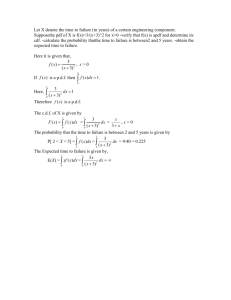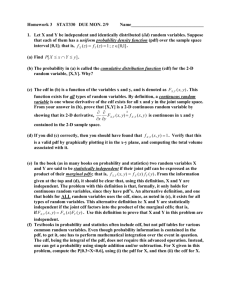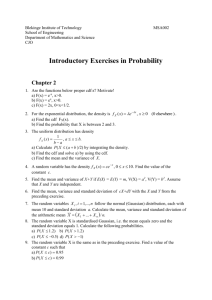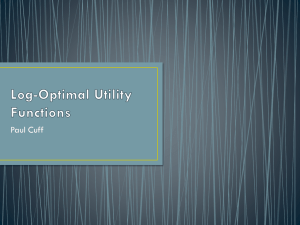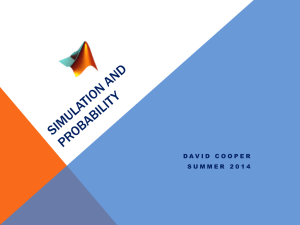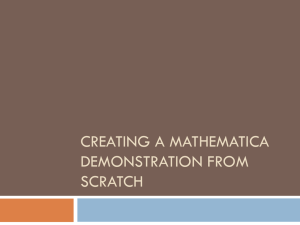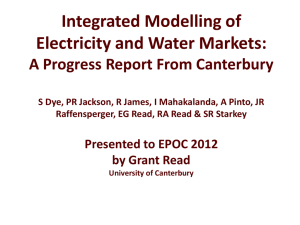Optimal inspection times for renewal strategies
advertisement
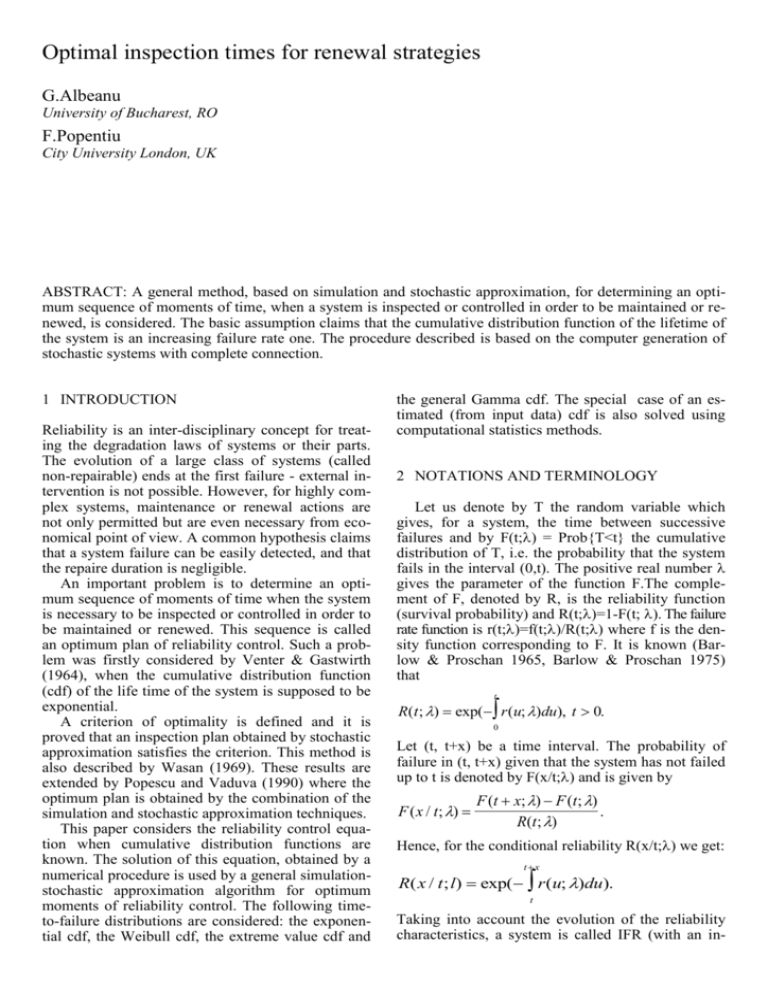
Optimal inspection times for renewal strategies
G.Albeanu
University of Bucharest, RO
F.Popentiu
City University London, UK
ABSTRACT: A general method, based on simulation and stochastic approximation, for determining an optimum sequence of moments of time, when a system is inspected or controlled in order to be maintained or renewed, is considered. The basic assumption claims that the cumulative distribution function of the lifetime of
the system is an increasing failure rate one. The procedure described is based on the computer generation of
stochastic systems with complete connection.
1 INTRODUCTION
Reliability is an inter-disciplinary concept for treating the degradation laws of systems or their parts.
The evolution of a large class of systems (called
non-repairable) ends at the first failure - external intervention is not possible. However, for highly complex systems, maintenance or renewal actions are
not only permitted but are even necessary from economical point of view. A common hypothesis claims
that a system failure can be easily detected, and that
the repaire duration is negligible.
An important problem is to determine an optimum sequence of moments of time when the system
is necessary to be inspected or controlled in order to
be maintained or renewed. This sequence is called
an optimum plan of reliability control. Such a problem was firstly considered by Venter & Gastwirth
(1964), when the cumulative distribution function
(cdf) of the life time of the system is supposed to be
exponential.
A criterion of optimality is defined and it is
proved that an inspection plan obtained by stochastic
approximation satisfies the criterion. This method is
also described by Wasan (1969). These results are
extended by Popescu and Vaduva (1990) where the
optimum plan is obtained by the combination of the
simulation and stochastic approximation techniques.
This paper considers the reliability control equation when cumulative distribution functions are
known. The solution of this equation, obtained by a
numerical procedure is used by a general simulationstochastic approximation algorithm for optimum
moments of reliability control. The following timeto-failure distributions are considered: the exponential cdf, the Weibull cdf, the extreme value cdf and
the general Gamma cdf. The special case of an estimated (from input data) cdf is also solved using
computational statistics methods.
2 NOTATIONS AND TERMINOLOGY
Let us denote by T the random variable which
gives, for a system, the time between successive
failures and by F(t;) = Prob{T<t} the cumulative
distribution of T, i.e. the probability that the system
fails in the interval (0,t). The positive real number
gives the parameter of the function F.The complement of F, denoted by R, is the reliability function
(survival probability) and R(t;)=1-F(t; ). The failure
rate function is r(t;)=f(t;)/R(t;) where f is the density function corresponding to F. It is known (Barlow & Proschan 1965, Barlow & Proschan 1975)
that
t
R(t ; ) exp( r (u; )du), t 0.
0
Let (t, t+x) be a time interval. The probability of
failure in (t, t+x) given that the system has not failed
up to t is denoted by F(x/t;) and is given by
F ( x / t; )
F (t x; ) F (t; )
.
R(t; )
Hence, for the conditional reliability R(x/t;) we get:
tx
R( x / t ; l) exp( r (u; )du).
t
Taking into account the evolution of the reliability
characteristics, a system is called IFR (with an in-
creasing failure rate) if the conditional reliability
function R(x/t;) decreases with t for any x0, i.e.
the reliability decreases with age. The systems with
an increasing conditional reliability function is
called DFR (with decreasing failure rate).
In this paper we consider an IFR system which is
inspected at times t1, t2, .... When the inspection reveals the inoperativity of the system, it will be repaired or replaced; otherwise nothing will be done.
We are interested in obtaining a sequence of such inspection moments, but in an optimal way. The optimality is defined in the sense of maximization of the
average information obtainable from a such plan after n inspections (Wasan 1969).
5 Output t1, t2, ..., tN;
6 End.
In order to implement such a procedure we need:
an algorithm to generate the sequence {Un}nN*;
an algorithm to generate the chain {Yn}nN*;
an algorithm to evaluate the function n.
Various algorithms are available to generate random
variables (Popescu & Vaduva 1990). The solution
chosen to obtain the function n is based on stochastic approximation (Venter & Gastwirth (1964), Wasan (1969)).
The information gained by using a control plan of
n inspections is given by:
1 d
J n ( ): E log Ln ( ) ,
n d
2
3 THE RELIABILITY CONTROL EQUATION
Following Popescu & Vaduva (1990), let us denote
the inter-inspection times by T1, Ti=ti-ti-1 for i2. Let
{Un}nN* be a sequence of i.d. random variables
whose probability distribution does not depend on ;
and define {Tn}nN* such as:
T1=max{0,U1}
Tn+1=max{0,n(Y1,Y2,...,Yn)+Un}, n1,
where n is a function of n varaiables, and (Yi)i 1 is
a binary random variable which has the following
probability distribution:
1
0
Yi :
,
R(Ti ; ) F (Ti ; )
taking on the value zero if at the ith inspection the
controlled system is down and taking on the value
one, otherwise.
Using the random chains terminology (Barlow &
Proschan (1965), Barlow & Proschan (1975), Birolini (1985), Birolini (1997), Iosifescu & Theodorescu
(1969), Popescu & Vaduva (1990) etc.)), the above
construction gives:
{Tn}nN* -- a Markov chain.
{Yn}nN* -- a stochastic chain with complete connections.
where log is the natural logarithm and Ln denotes the
likelihood function of based on the sampling (Y1,
..., Yn, T1, ..., Tn):
n
Ln ( ) R(Ti ; ) Yi F (Ti ; ) 1Yi .
i 1
In order to maximize the functional Jn, the following
reliability control equation it is necessary to be
solved:
r (u; )
du
0
2 log r (T ; )
,
F ( T ; )
T
for the unknowns T and . If is known then the inspections are placed at the periodic times obtained
from Ti:=T*, where T* is the solution of the above
equation. When is an unknown parameter, a stochastic approximation plan it is necessary to be
built-up. It follows, from Popescu & Vaduva (1990),
that
J n ( ) 2
A stochastic approximation plan such as
liminf J n ( ) 2
n
The computer generation of a stochastic chain with
complet connection is discussed in Popescu & Vaduva (1990). Following this scheme an algorithm for
obtaining the optimum moments of reliability control consists in the following steps:
1
2
3
4
Input N - the length of the control trajectory;
Generate U1; T1:= max {0, U1}; t1:=T1;
n:=1;
While n<N do [a) Generate Yn; Tn+1:= max {0,
n(Y1, Y2, ..., Yn) + Un };b) Generate Un+1;
tn+1:=Tn+1 + tn; c) n:=n+1];
R(T *; )
log r (T *; )
.
F (T *; )
R(T *; )
log r (T *; )
F (T *; )
is called to be adaptive.
The following particular cases are important
enough in reliability:
If F(T;)=1-exp(-T) (the exponential cdf), the
renewal control equation becomes exp(-T)=1T/2.
If F(t, )=1-exp(T) (the Weibull cdf), T* is the
solution of the equation 2(1+logT)(1-exp(T))=Tlog T.
If F(t, )=1-exp(-(eT-1)/ ) (the extreme value
cdf), the solution T* is given by T*=log (1+x*),
where x* is the solution of the equation 1x/2=exp(-x).
In the next section will be considered the Gamma
cdf defined for a positive integer shape parameter.
However, the procedure developed is suitable for
any IFR cdf.
4 A GENERAL STOCHASTIC
APPROXIMATION ALGORITHM
Let a and b such as 0<a<b. Assume that p
(0,1) is given. Take Ta such as R(Ta,a)=p and Tb
such as R(Tb,b)=p. A stochastic approximation plan
considers an arbitrary T1 in (Ta,Tb) and iteratively
follows the sequence:
Let n be the solution of the control reliability
equation
r (u; )
du
0
2 log r (Tn ; )
.
F (Tn ; )
Tn
Compute pn:=R(Tn,n) and take An:=( n pn)-1.
Update Tn+1=max{Ta, min {Tb, Tn+An(Yn-p)/n}}.
denote by Wn:=n-1 An(Yn-p) and to use the same arguments as in the theorem related to the exponential
cdf from (Wasan 1969).
In the following the Gamma cdf will be considered. For a given N*, let us denote by f(t;) the
density probability of the Gamma distribution (with
a positive integer shape parameter):
t 1
f (t ; )
exp( t ), t 0, 0.
( 1)!
It is well known (Barlow & Proschan 1975) that the
corresponding cdf F is an IFR one, for >1 and is
given by:
1
F (t ; ) 1 exp( t ) ( t ) i i !.
i 0
For a general N*, the reliability control equation
is very difficult to solve and numerical procedures to
solve it will be reported elsewhere. In this paper we
consider only the particular case with =2. With this
assumption the reliability control equation becomes:
2(2+T)[1-exp(-T)(1+T)]=(T)2.
Using x:=T0 we obtain the nonlinear equation
Hence, the general stochastic approximation algorithm consists in the following steps:
1 Input a, b, p and N;
2 Compute Ta as the solution of the equation
R(t;a)=p;
3 Compute Tb as the solution of the equation
R(t;b)=p;
4 Generate T1 as uniform random number in (Ta,
Tb);
5 Take t1:=T1; n:=1;
6 While n<N do {
Solve the control reliability equation for the unknown . Assume n is the obtained solution;
Compute pn:=R(Tn; n) and take An:=(n pn)-1;
Generate Yn a random variable distributed as:
0
1
Yn :
;
pn 1 pn
7
8
Take Tn+1=max [Ta, min{Tb, Tn+An(Yn-p)/n}];
Take tn+1:=tn+Tn+1;
n:=n+1;}
Output t1, t2, ..., tN;
End.
For the particular cases described above, An depends
only on p and Tn, it follows that n(Y1, ..., Yn) =
An(Yn-p)/n depends only on p and Tn.
The inspection plan built-up by the above stochastic algorithm is an adaptive one. It suffices to
x2 2x 4
exp( x )
, x [0, ),
2(2 x )(1 x )
which has x0:=2.58975 as an unique solution belonging to the interval (0,3).
Therefore, in the first part of the loop 6 in the
above algorithm, n can be obtained by n:=x0/Tn.
Moreover, the equation R(t; )=p, for the unknown t
is solved in the following two steps: 1) find y0 such
that exp(-y0)(1+y0)=p and 2) compute t by t:=y0/n.
In the end of this section we deal with estimated
cumulative distribution functions. Some methods to
obtain density estimates based on sample data are
known in literature (Silverman 1986). The density
estimates that have been most heavely used are kernel density estimates. However, recently a new approach, namely the logspline density estimation, appered.
When the density probability f is already obtained
and the system under study is an IFR one, the above
stochastic approximation technique can be used.
A Pascal program for testing the presented approach was written. Both kernel and logspline methods are implemented. The obtained results are encouraged.
5 CONCLUSIONS
This paper deals with the inspection process in reliability. The simulation and the stochastic approximation are the techniques used in order to obtain inspection plans for IFR systems.
The preliminary results obtained using a computer
program, which implements the algorithm given
above for different cumulative distribution functions, are encouraged. The following time-to-failure
distributions are considered: the exponential cdf, the
Weibull cdf, the extreme value cdf and the general
Gamma cdf. The special case of an estimated (from
input data) cdf is also solved by computational statistics techniques heavely implemented to obtain
such inspection plans.
REFERENCES
Barlow, R.E.& F. Proscha 1965. A Mathematical theory of reliability. New York: John Wiley.
Barlow, R.E. & F. Proschan 1975. Statistical theory of reliability and life testing. Probability models. New York: Holt,
Rinehart and Winston.
Birolini, A. On the use of stochastic processes in modeling reliability problems, Lecture Notes 252 in EC & Math. Syst.,
Springer, 1985.
Birolini, A. Quality and reliability of technical systems,
Springer, 1997.
Iosifescu, M. & R. Theodorescu 1969. Random processes and
learning. Springer Verlag.
Kooperberg, C. & C.J. Stone 1991. A study of logspline density estimation. Computational Statistics & Data Analysis.
12(3):327-349.
Popescu, I. & I. Vaduva 1990. An optimum plan of reliability
control. Computing. 44:159-168.
Silverman, B.W. 1986. Density estimation for statistics and data analysis. London: Chapman and Hall.
Venter, J.H. & J.L. Gastwirth 1964. Adaptive statistical procedures in reliability and maintenance problems. Technical
Report No. 99. Department of Statistics. Stanford University.
Wasan, M.T. 1969. Stochastic approximation. Cambridge University Press.
